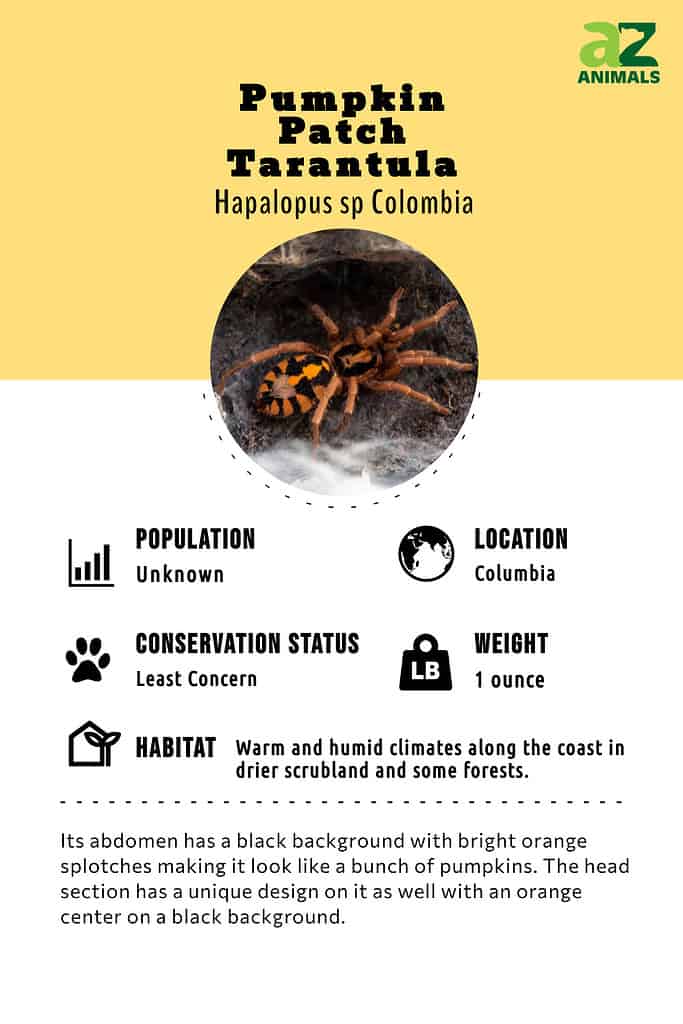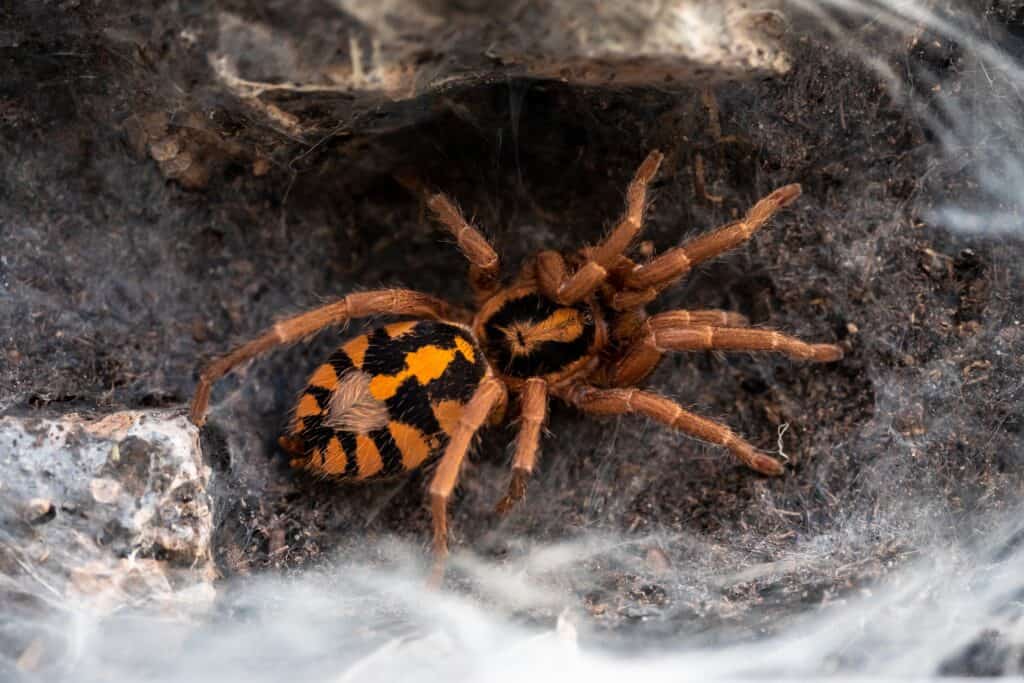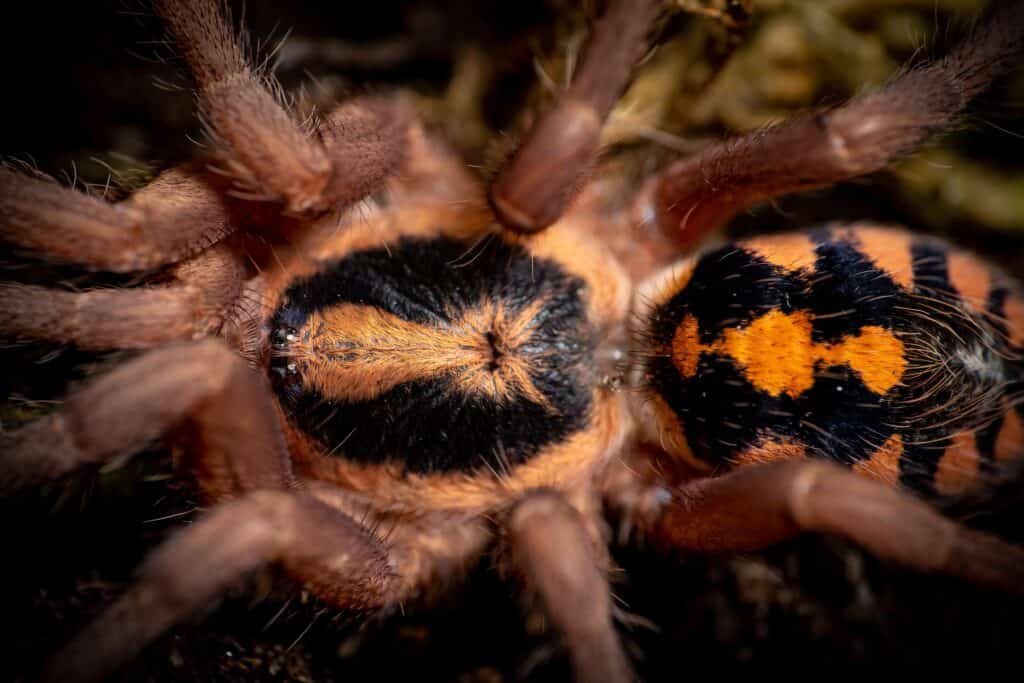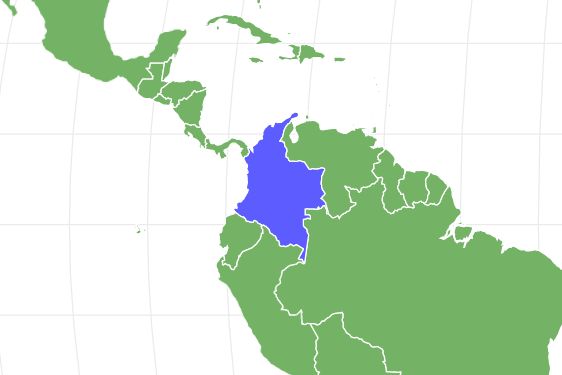Pumpkin Patch Tarantula
Hapalopus sp Columbia
They are considered dwarf tarantulas.
Advertisement
Pumpkin Patch Tarantula Scientific Classification
- Kingdom
- Animalia
- Phylum
- Arthropoda
- Class
- Arachnida
- Order
- Araneae
- Family
- Theraphosidae
- Genus
- Hapalopus
- Scientific Name
- Hapalopus sp Columbia
Read our Complete Guide to Classification of Animals.
Pumpkin Patch Tarantula Conservation Status
Pumpkin Patch Tarantula Facts
- Prey
- insects, frogs, lizards, birds, crickets, mealworms
- Main Prey
- insects
- Name Of Young
- spiderlings
- Group Behavior
- Solitary
- Fun Fact
- They are considered dwarf tarantulas.
- Most Distinctive Feature
- Pumpkin designed backs
- Temperament
- Mild mannered
- Habitat
- scrubland and forests, terrestrial
- Diet
- Carnivore
- Lifestyle
- Nocturnal
- Location
- Columbia
View all of the Pumpkin Patch Tarantula images!
Not stripes or spots, but a pumpkin design!
Pumpkin patch tarantulas have a design on their abdomen that looks like a pumpkin patch. Their abdomens are black with several bright orange pumpkin-shaped splotches. Their head section is dark brown with black and orange markings and they have long, segmented, dark brown legs. They are a New World tarantula found in Columbia in South America. Pumpkin patch tarantulas are sometimes kept as pets due to their unique markings.
Amazing Facts
- They are considered dwarf tarantulas due to their smaller size.
- The smallest type are only two and a half inches with the larger ones being three to four inches.
- Pumpkin patch tarantulas are a New World spider similar to California Tarantulas.
- They are considered fast and a bit skittish.
- They live in burrows in the ground and come out at night.

Scientific Name
The scientific name of the Pumpkin patch tarantula is Hapalopus sp Colombia. The word Hapalopus means “simple foot” and Colombia refers to their country of origin, Columbia. They belong to the family of Theraphosidae along with around 1,000 other tarantula species.
Evolution And Origin
Of the only two tarantula fossils in existence, one is about 100 million years old from Myanmar, and the other about 16 million years old from Mexico, it was established that this arachnid is an ancient spider, first emerging around 120 million years ago, during the Cretaceous period, in what is now considered the Americas. At the time it was still the supercontinent of Gondwana, allowing tarantulas the opportunity to spread across the then-joined landmasses of the Americas into Africa, Australia, and India, and with a further separation of land, these hairy spiders made their way further to Asia.
Types Of
The pumpkin patch tarantula is a dwarf species of tarantula of which there are more than 75 species. There are two types of pumpkin patch tarantulas the Groot (larger) and Klein (smaller) with the larger ones getting to be three to four inches and the smaller ones two and a half inches in length. A few additional beautiful dwarf species are:
- Brazilian blue dwarf beauty tarantula (Dolichothele diamantinensis)
- Brazilian Jewel Tarantula (Typhochlaena Seladonia)
- Trinidad Dwarf Tarantula (Cyriocosmus elegans)
- Chilean Dwarf Flame Tarantula (Homoeomma chilensis)
- Dwarf Pink Leg Tarantula (Kochiana brunnipes)
Appearance

The pumpkin patch tarantula is also known as
hapalopus formosus
.
©tempisch/Shutterstock.com
The differences between tarantula species’ appearances are remarkable. The pumpkin patch tarantula gets its name from the pattern on its abdomen. It has a black background with bright orange splotches making it look like a bunch of pumpkins. The head section (carapace) has a unique design on it as well with an orange center on a black background. Their eight long legs are dark brown and covered in spiky hairs.
The pumpkin Patch tarantula is considered a dwarf tarantula with the smaller ones being only two and a half inches long; the top of a soda can is about two inches across, so you have an idea of how small they are. The bigger ones, the Gros, are about three to four inches in length, so a little larger than a credit card. At the front of their bodies, they have two additional appendages called pedipalps and at their other end are two spinnerets.
Behavior

pumpkin patch tarantula
©tempisch/Shutterstock.com
The most notable behavior of the pumpkin patch tarantula is its speed. They are considered docile and can be a bit skittish. If they are threatened, they are more likely to flee than fight. They have urticating hairs that they can flick at a threat, but they rarely use them as their first line of defense is to get away and hide in their burrow.
They spend their days deep in their burrows out of harm’s way and creating extensive web tunnels. Pumpkin patch tarantulas cover the entrance of their home with thick webbing. During the night, they come up to the opening of their burrow and will wait for prey, such as an unsuspecting grasshopper, to wander by, and then they snatch it. They use their webs to wrap their prey and then inject it with digestive juices to liquefy it. Using a straw-like mouth they suck up the nutrients for dinner.
Habitat
The habitat of the pumpkin patch tarantula is the warm and humid climate of Columbia. They are found along the coast in drier scrubland and some forests. As a terrestrial animal, they live on the ground and spend much of their time in deep burrows. The burrows are lined with silky web tunnels that keep the tarantulas safe.
As solitary animals, they live alone in their burrow and only come together to mate. If kept as a pet, they should be kept in an enclosure alone and not with other tarantulas. They prefer a temperature between 75°F to 80°F with high humidity.
Predators And Threats
The pumpkin patch tarantula has several common predators including other spiders, lizards, birds and snakes. Other animals that are nocturnal, out at the same time as pumpkin patch tarantulas, pose a bigger threat. The larger Gros tarantulas are better equipped to fend off bigger prey, but the smaller Klein ones are fast and can get away quickly.
They have urticating hairs they can flick at a predator, and their bites are venomous, however, as a smaller spider they have smaller fangs. Keeping hidden deep in their burrows during the day helps protect them as well as their extensive web tunnels.
What Eats Pumpkin Patch Tarantulas?
Animals that eat pumpkin patch tarantulas include snakes, lizards, birds and larger spiders. One of the biggest threats to the tarantula is the tarantula hawk. These animals are not birds, but large wasps that eat tarantulas. They don’t feed directly on tarantulas but paralyze them and bury them alive. The tarantula hawk will insert one egg into the tarantula’s abdomen, and when the larvae hatch, it has a dinner all ready for it.
What Do Pumpkin Patch Tarantulas Eat?
Pumpkin patch tarantulas eat mostly insects but they will also eat frogs, lizards, small birds, and small mice. When they sense the movement of a prey passing by they lunge at it and grab it with their pedipalps. They quickly use their web to wrap it up and may inject it with venom if they need to. They use their venom and digestive juices to liquefy their prey before sucking up the nutrients.
As pets you can feed your pumpkin patch crickets, Dubia roaches and mealworms. Choose smaller insects for the smaller tarantulas or break them into smaller chunks.
Conservation Status
Pumpkin patch tarantulas are not listed by the IUCN as a threatened animal. They are only found in Columbia but are also bred in captivity. This species is considered easy to breed.
Reproduction, Babies, And Lifespan
Pumpkin patch tarantulas are solitary animals except when it is time to mate. The males will leave their burrows in search of a female. While some tarantula species’ females are unreceptive or aggressive, the pumpkin patch tarantulas seem to be more easygoing. Once a male finds a receptive female, it will spin a sperm web where he can deposit his sperm and then transfer it to the females opening in her abdomen.
Despite their smaller size, the females can lay around 400-500 eggs. The mother will knead and turn the egg sac and keep it safe in her burrow until the spiderlings hatch. Can you imagine 50 tiny spiders crawling around once they are let loose? Like other tarantulas, the spiderlings will stay with the mother for a few weeks before taking off on their own.
The life span of the pumpkin patch tarantula is shorter than most tarantulas. Compared to Mexican redknee tarantulas that live to be 20 years old or more, they have a short life, but compared to black widow spiders that only live one to three years, they have a long life span. Males can live to be three to four years old and females live eight to ten years.
Population
Counting tiny tarantulas in the wild is quite a task so the population of these pumpkin-backed spiders is unknown. The IUCN does not have them listed as threatened so it can be assumed that they have a healthy population count.
Related Animals
View all 192 animals that start with PPumpkin Patch Tarantula FAQs (Frequently Asked Questions)
Are pumpkin patch tarantulas venomous?
Yes, they are venomous, but their venom is not harmful to humans. They are not an aggressive spider and rarely bite.
How big do pumpkin patch tarantulas get?
The smaller ones (Kleins) are around two and a half inches while the larger ones (Gros) are three to four inches.
Do pumpkin patch tarantulas make webs?
Yes, they make lots of webs, especially in their burrow and at the entrance. They don’t use these to catch prey like other spiders, but they use the webs as protection.
Where are Pumpkin patch tarantulas found?
They are native to the country of Columbia in South America.
Are pumpkin patch tarantulas good pets?
Yes, they make good pets if you want a “display pet.” They are interesting to watch and make interesting web tunnels.
Can you pick up a pumpkin patch tarantula?
It is better not to handle a pumpkin patch tarantula. They can quickly dart away if startled and could get injured if they fall. It is better to have them on display in their enclosure vs. taking them out to hold them.
Thank you for reading! Have some feedback for us? Contact the AZ Animals editorial team.
Sources
- Thetarantulacollective.com, Available here: https://www.thetarantulacollective.com/caresheets/hapolopus-sp-colombia
- Ultimate Exotics Reptile Breeding Facility, Available here: https://ultimateexotics.co.za/the-pumpkin-patch-tarantula-hapalopus-sp-colombia-by-tim-surman-from-www-petbugs-co-za/
- Reptile Range, Available here: https://www.reptilerange.com/pumpkin-patch-tarantula/
- Live Science, Available here: https://www.livescience.com/tarantulas-global-takeover.html

















